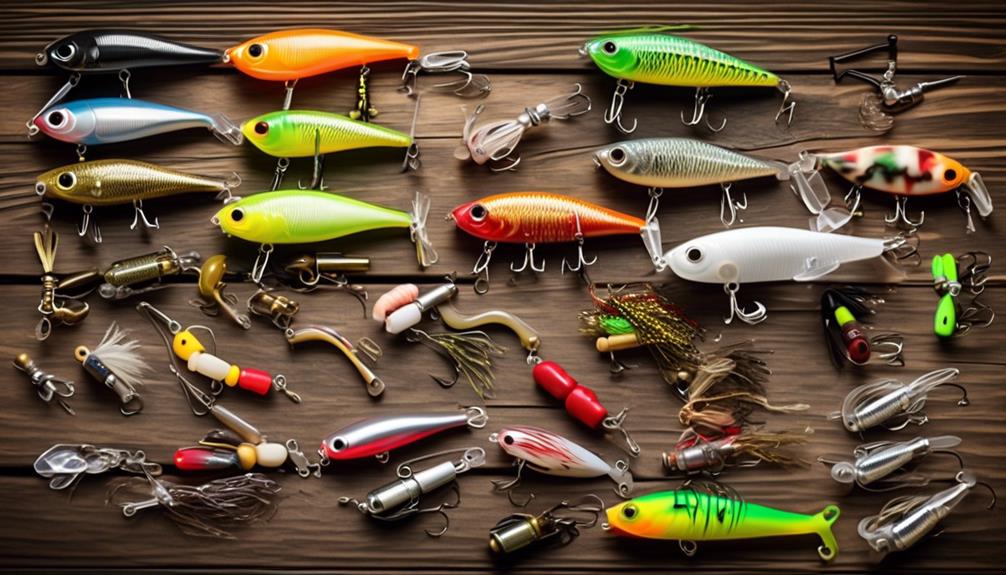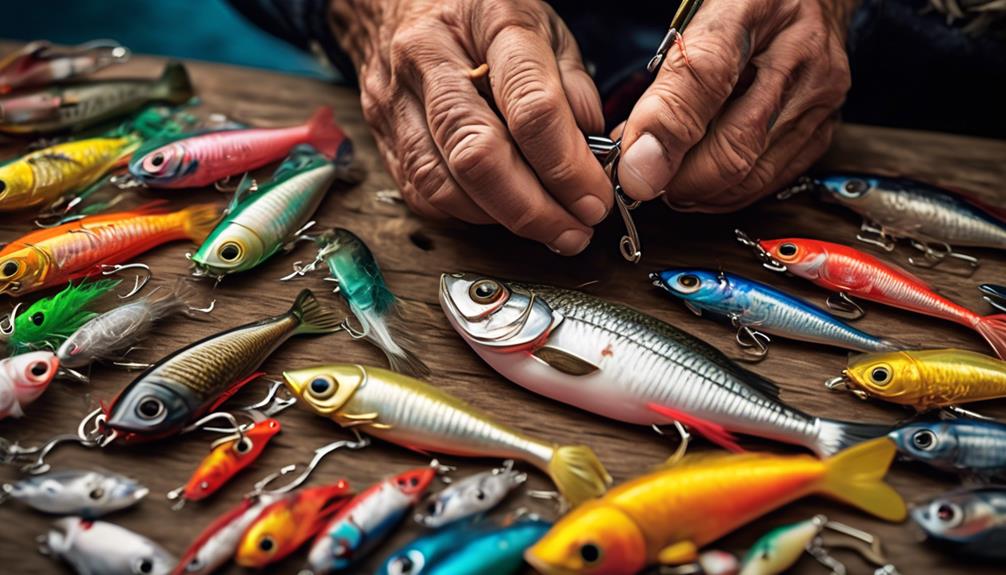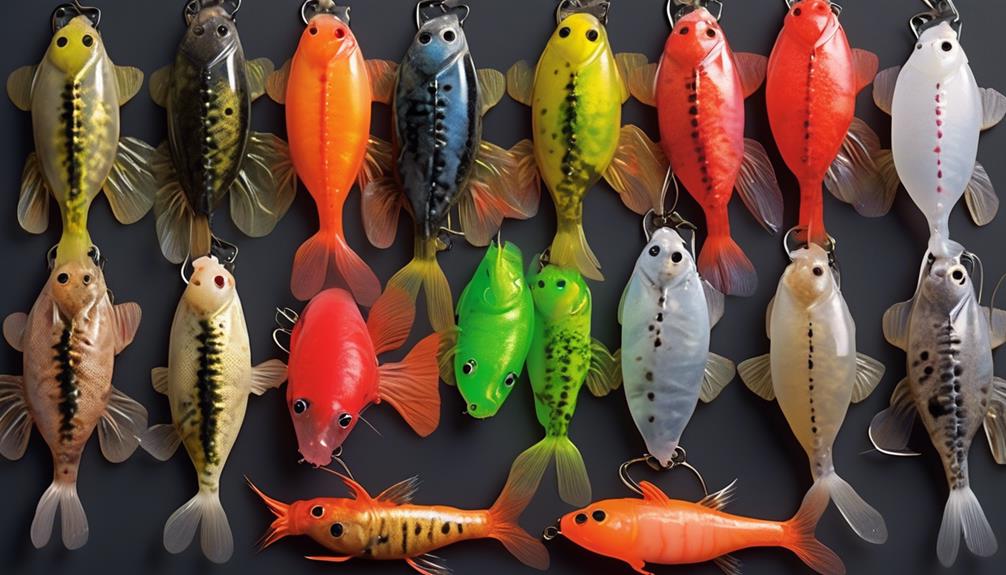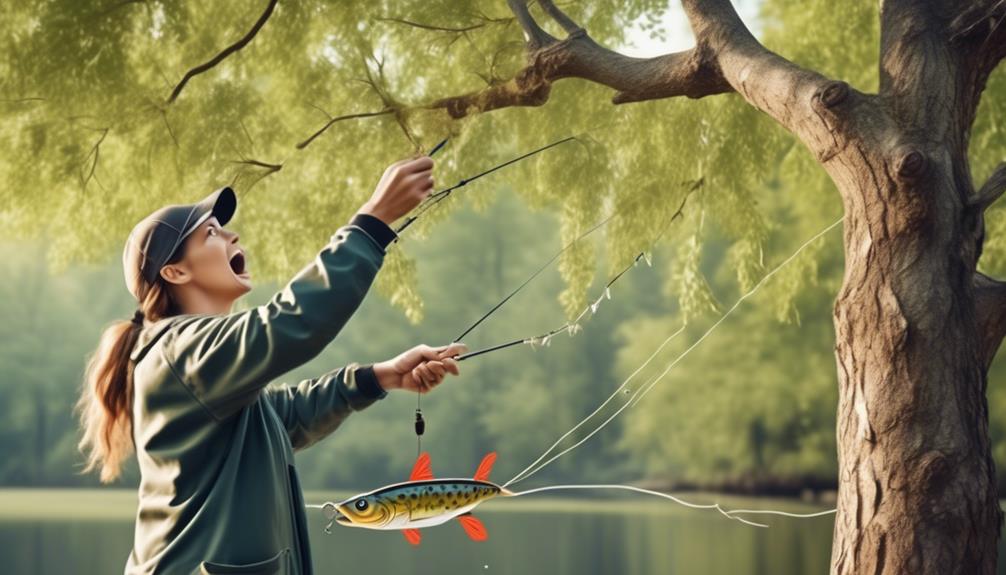When it comes to bass fishing, choosing the right bait is like selecting the perfect tool for the job. You want to ensure you have the best chance of reeling in a big catch, and that starts with the bait you use.
But why are certain baits and lures consistently ranked as the top choices for bass fishing? There's a reason why these particular options have gained such a reputation, and understanding the science behind their effectiveness can make a world of difference in your next fishing trip.
Spinnerbaits
When targeting bass, spinnerbaits offer versatility and effectiveness due to their flashy blades and vibrant skirts, making them a popular choice among anglers. Spinnerbaits are incredibly versatile and can be fished in various ways to entice bass. One effective technique is to slow roll the spinnerbait along the bottom, allowing the blades to thump and the vibrant skirt to pulsate, mimicking a wounded baitfish. Another technique involves yo-yoing the spinnerbait, where you lift and drop your rod tip to make the bait rise and fall erratically, triggering aggressive strikes from bass.
The best spinnerbait colors often depend on water clarity and light conditions. In clear water and bright conditions, natural colors like shad, bluegill, or silver can be effective. In stained or murky water, brighter and bolder colors such as chartreuse, white, or even black can help bass locate the bait more easily. Pairing the spinnerbait with the right trailer can also enhance its appeal. Adding a soft plastic trailer, such as a curly tail grub or a paddle tail swimbait, can provide extra action and bulk to the bait, making it more enticing to bass.
Furthermore, the design of spinnerbait blades plays a crucial role in its effectiveness. Willow blades create a tight, flashy vibration and work well in clearer water, while Colorado blades displace more water, producing a slower thump that can be effective in murkier conditions or when bass are less active. Understanding these spinnerbait techniques, best colors, trailers, and blade designs can help you make the most out of this versatile and effective bass fishing lure.
Crankbaits
Crankbaits are a popular choice for bass anglers due to their ability to cover water quickly and effectively, allowing you to locate actively feeding fish. When it comes to crankbait design, there are a few key features to consider:
- Lip Shape: The design of the lip determines the depth the crankbait will dive to when retrieved. Round lips generally create a wider wobble and are great for shallower waters, while square-billed crankbaits are ideal for deflecting off cover in deeper areas.
- Buoyancy: The buoyancy of a crankbait affects its action when retrieved. Floating crankbaits rise when the retrieve is paused, making them excellent for fishing over vegetation or shallow cover. On the other hand, sinking crankbaits are perfect for targeting deeper structures.
- Color Patterns: Crankbaits come in a variety of color patterns to mimic different forage species. It's essential to have a selection of colors to match the prevalent forage in the waters you're fishing.
- Rattle Chambers: Many crankbaits are equipped with rattles that emit sound, attracting bass in murky or stained waters.
In addition to understanding crankbait design, mastering various retrieval techniques is crucial for success. Experiment with different retrieval speeds, pauses, and jerks to imitate the erratic movements of injured baitfish, triggering aggressive strikes from bass. By varying your crankbait retrieval techniques, you can effectively entice bass in a range of conditions.
Jigs
Considered one of the most versatile lures in bass fishing, jigs offer anglers a wide range of presentation options for targeting bass in various conditions. When it comes to jig fishing techniques, it's crucial to understand the best locations to use them.
Jigs excel in areas with heavy cover, such as brush piles, submerged trees, and thick vegetation. Pitching or flipping jigs into these areas allows for precise presentations and entices bass hiding in the cover to strike.
For successful jig fishing, selecting the right jig trailer options and color choices is essential. Trailer options like chunk-style trailers, crawfish imitators, or creature baits can enhance the jig's action and appeal. Choose trailers that complement the jig's profile and mimic natural prey in the waterbody.
Additionally, color choices play a significant role in attracting bass. In clear water, natural hues like green pumpkin or watermelon are effective, while stained or murky waters may call for darker colors such as black and blue. Experimenting with different colors based on water clarity and forage can help determine the most productive options.
To maximize your chances of bass fishing success with jigs, adapt your techniques to the specific conditions and locations you encounter. By carefully selecting trailers and colors and utilizing the right jig fishing techniques, you can effectively target bass in diverse environments.
Soft Plastic Baits
After mastering the versatility of jigs in bass fishing, you'll now explore the effectiveness of soft plastic baits in enticing bass to strike in various conditions. Soft plastic baits come in a wide variety of shapes, sizes, and colors, making them a versatile choice for anglers. Whether you're fishing in clear water, murky conditions, or heavily vegetated areas, soft plastics can be an excellent option for targeting bass.
When it comes to fishing techniques, soft plastic baits can be used in a myriad of ways to appeal to bass in different scenarios. Here are some popular techniques for using soft plastic baits:
- Texas Rig: This rig allows the soft plastic bait to be worked through heavy cover without getting snagged, making it a great choice for fishing in areas with dense vegetation.
- Carolina Rig: Ideal for covering larger areas, the Carolina rig allows the soft plastic bait to float above the bottom, enticing bass in deeper waters.
- Drop Shot: This finesse technique involves presenting the soft plastic bait above a weight on the bottom, making it an effective approach for enticing finicky bass in clear water.
- Wacky Rig: This simple yet effective technique involves hooking the soft plastic bait in the middle, allowing it to exhibit a tantalizing wobbling action as it's worked through the water.
When it comes to bait selection, soft plastic baits offer an extensive range of options, including worms, creature baits, crawfish imitations, and more. Each type of soft plastic bait can excel in specific conditions, so experimenting with different options is key to finding what works best in your fishing environment.
Topwater Lures
Ready to entice bass to strike aggressively at the water's surface? Topwater lures are designed to do just that. These lures create surface action and water disturbance, mimicking the movements of prey, which can trigger explosive strikes from bass. When using topwater lures, it's all about the visual and auditory appeal. The excitement of seeing a bass break the water's surface to attack a topwater lure is unparalleled in the world of bass fishing.
One of the most popular types of topwater lures is the popper. This lure features a concave mouth that, when twitched, creates a splashing and popping sound, imitating a distressed or wounded baitfish. Bass are drawn to this commotion and will often strike aggressively.
Another effective topwater lure is the propeller or buzzbait. As the lure is retrieved, the propeller spins, creating a surface disturbance and mimicking the sound of a fleeing or injured prey. This combination of visual and auditory stimulation can be irresistible to bass.
The walk-the-dog style lure is another topwater favorite. This lure is designed to zig-zag back and forth across the water's surface, creating a realistic movement that bass find hard to resist.
Whether it's a popper, propeller, or walk-the-dog lure, the key to success with topwater lures is to impart action that mimics a vulnerable prey, enticing bass to strike with voracity.
Swimbaits
If you've had success with topwater lures, you may want to try swimbaits to target bass in a different way. Swimbaits are incredibly effective for catching bass, and their versatility makes them a must-have in any angler's tackle box.
- Swimbaits effectiveness
Swimbaits are highly effective at mimicking the natural movement of baitfish, making them irresistible to bass. Their lifelike appearance and action in the water often result in aggressive strikes from big bass. Whether you're fishing in clear water, around structure, or in open water, swimbaits consistently produce results.
- Swimbaits versatility
One of the key advantages of swimbaits is their versatility. They come in various sizes, shapes, and colors, allowing you to match the local forage and adapt to different fishing conditions. From slow-sinking models for targeting suspended bass to paddle-tail swimbaits for covering water quickly, there's a swimbait for every situation.
Swimbaits can be fished at different depths, from the surface to deep water, making them suitable for various bass fishing scenarios. Whether you're targeting largemouth, smallmouth, or spotted bass, swimbaits can be tailored to entice bites from these different species.
Jerkbaits
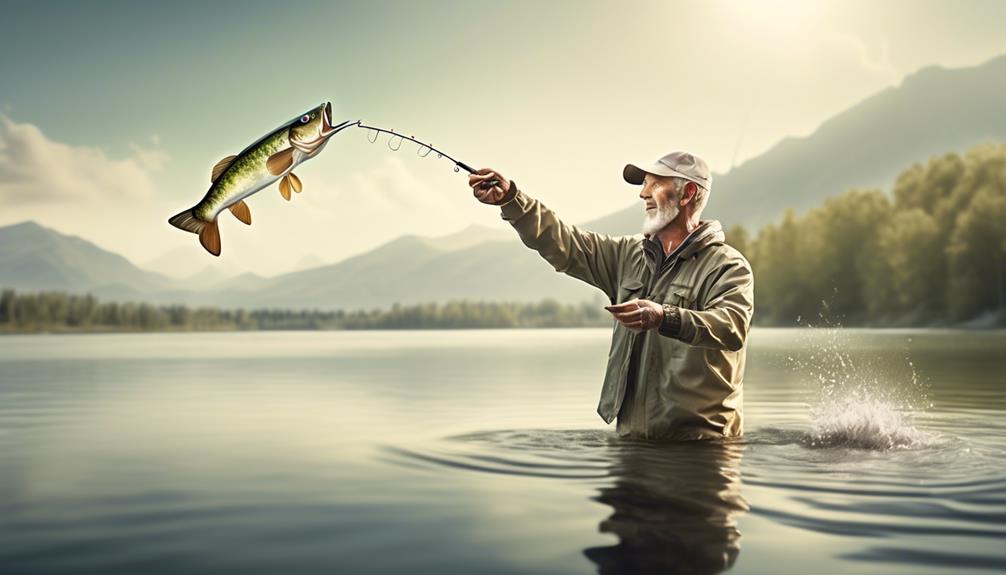
You can enhance your bass fishing technique by incorporating jerkbaits into your arsenal of lures. Jerkbaits are incredibly effective in mimicking injured baitfish, making them a go-to choice in various conditions. When using jerkbaits, mastering the right techniques is crucial. The erratic, darting motion of jerkbaits can trigger aggressive strikes from bass, especially in colder water or when fish are less active. Incorporating pauses and twitches in your retrieval can simulate a wounded baitfish, enticing bass to strike.
In a jerkbaits vs. crankbaits comparison, jerkbaits excel in colder water and during the pre-spawn and post-spawn periods. Their ability to suspend and create a wounded baitfish action is particularly effective when bass aren't as willing to chase down fast-moving crankbaits. Jerkbaits are also suitable for fishing in clear water, as their realistic movement can trick even the most cautious bass into striking.
However, in warmer water or when bass are actively feeding near the surface, crankbaits might be more effective due to their diving and wobbling action, covering more water and attracting aggressive strikes.
Worms and Craws
Incorporate worms and craws into your bass fishing strategy to entice bites from finicky bass in various conditions. These versatile baits can be highly effective in enticing bass to strike, especially when other baits fail to produce results. Here's why you should consider adding worms and craws to your bass fishing arsenal:
- Natural Presentation: Worms and craws closely mimic the natural prey of bass, making them highly enticing to the fish. Their lifelike movements and appearance make them difficult for bass to resist.
- Versatility: Both worms and craws can be fished in a variety of ways, including Texas rigging, Carolina rigging, or even wacky rigging. This versatility allows you to adapt to different conditions and cover various depths effectively.
- Year-Round Effectiveness: Worms and craws can produce bites throughout the year, making them reliable options in both warm and cold water conditions. Whether it's spring, summer, fall, or winter, these baits can consistently attract bass.
- Craw Imitations, Effective or Overrated?: While some anglers swear by craw imitations, others question their true effectiveness. Experimenting with different craw imitations and observing bass behavior can help you determine their effectiveness in your fishing area.
When it comes to worms vs. craws, both have their time and place. Ultimately, the decision of which bait is the ultimate bass magnet depends on the specific conditions you're fishing in and the behavior of the bass in that area. Experimentation and observation are key to determining which bait will be most effective on any given day.
Frequently Asked Questions
What Are the Best Conditions for Using Spinnerbaits?
When fishing with spinnerbaits in clear water, it's best to use them during bright, sunny days. The flash and vibration from the spinnerbait will be more visible to bass in these conditions.
Vary your retrieval techniques – slow and steady, erratic, or stop-and-go – to see what entices the bass. The key is to experiment and find the right rhythm that triggers strikes.
How Can I Effectively Use Soft Plastic Baits in Different Water Depths?
When fishing with soft plastic baits in shallow water, focus on using finesse techniques like wacky rigs or weightless Texas rigs.
For deep water bass fishing, try using techniques like Carolina rigs or drop shot rigs to target bass at different depths.
Adjust your presentation and retrieve based on the water depth and the behavior of the bass.
Experiment with different colors and sizes to find what works best for you.
Are There Specific Colors or Patterns That Work Best for Crankbaits in Murky Water?
In murky water, crankbait color and patterns play a key role in their effectiveness. Opt for bright and bold colors like chartreuse, orange, or red to maximize visibility. Patterns with contrasting colors can also attract bass in low visibility conditions.
When using crankbaits in murky water, focus on their ability to create vibrations and sound to attract bass, as visual cues may be limited. Adjust the retrieval speed and vary the depth to find the most effective technique.
Can You Provide Tips for Using Swimbaits in Areas With Heavy Vegetation?
When fishing swimbaits in open water, focus on a steady retrieve with occasional pauses to mimic injured baitfish. Utilize a slow, steady reel to keep the swimbait at the desired depth.
In areas with heavy vegetation, opt for weedless swimbaits and use a slow, steady retrieve to avoid getting caught.
Experiment with different swimbait sizes and colors to find what works best for the specific conditions you're fishing in.
What Are the Advantages of Using Worms and Craws Over Other Types of Bass Fishing Lures?
When it comes to bass fishing, worms and craws offer versatility and effectiveness. These baits excel in various fishing techniques and provide advantages over other lures.
Worms and craws can be used in different water conditions and are great for finesse fishing. They also mimic natural prey effectively, making them a preferred choice for bass.
Their realistic movements and subtle presentations often lead to increased success compared to other types of lures.
Conclusion
So, next time you're out on the water, make sure you have these top bass fishing baits and lures in your tackle box.
With their versatility and proven track record, you'll be sure to reel in some big bass.
Whether you're using spinnerbaits, crankbaits, jigs, or any of the other top baits and lures, you'll be ready to tackle any bass fishing challenge that comes your way.
Happy fishing!
